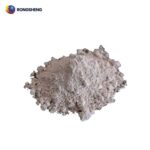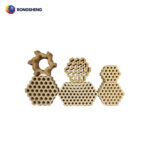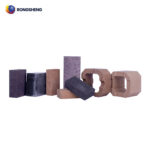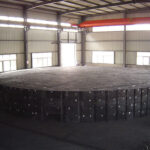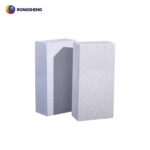Key Performance of Fused High Zirconium Bricks for Substrate Glass Furnaces
Fused high-zirconium bricks are the mainstream material for the walls and floors of gas-electric hybrid glass furnaces. As the production of high-quality glass increases, the increased flow rate exacerbates the scouring effect on the walls and floors. Consequently, during the glass melting process, fused high-zirconium bricks are inevitably corroded by the high-temperature molten glass and the various electrochemical atmospheres in the furnace, shortening the furnace’s lifespan. Therefore, key performance indicators of fused high-zirconium bricks for furnaces, such as thermal expansion, volume resistivity, resistance to molten glass corrosion, and foaming properties, play a crucial role in managing expansion during the furnace’s heating process, extending furnace life, and in the selection and development of fused high-zirconium brick materials.
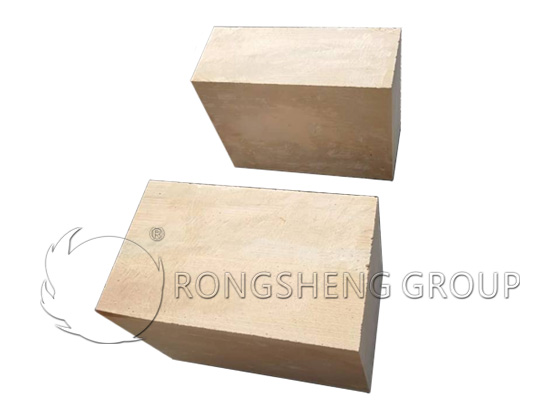
Key Performance of Fused High Zirconium Bricks
By testing and comparing the key performance of two different types of fused high zirconium bricks, such as thermal expansion rate, volume resistivity, resistance to glass erosion and foaming, the fused high zirconium brick material with the best performance is selected to provide technical support for the efficient and stable operation of the production line furnace.
(1) Thermal expansion rate
Two fused high zirconium brick materials A and B are processed into rectangular structures, and the size of the samples in the initial state is measured. The temperature is raised from room temperature to 1600 ℃ at 6 ℃/min, and the sample size is measured every 100 ℃ during the heating process. The sample volume and volume expansion rate are calculated at different temperatures.
From the volume expansion rate at different temperatures, it can be seen that the volume expansion rate of both materials shows an upward trend before 1100 ℃, with a high point of about 0.7%. After 1100 ℃, the volume shrinkage inflection point of material A appears first. It reaches a low point of 0.22% at 1200 ℃, and the volume shrinkage rate of material B reaches a low point of about 0.08% at about 1240 ℃. Through test comparison, it is found that the thermal expansion trends of the two electrofusion materials A and B are basically the same.
(2) Volume resistivity
The two fused high zirconium brick materials A and B were processed into cylindrical shapes, and platinum terminals were connected to the two ends of the cylinder, and the platinum terminals were connected to platinum wires. Then, the platinum wires at both ends of the sample were connected to a DC double-arm bridge. After fixing the test device, it was placed in a high-temperature pit furnace and heated to 1600 ℃ at a heating rate of 6 ℃/min. During the heating process, the resistance values corresponding to the two fused materials at different temperatures were measured, and then the high-temperature volume resistivity of the two fused materials at different temperatures was calculated.
From the high-temperature volume resistivity of the two fused high zirconium brick materials, it can be seen that the volume resistivity of material B is generally higher than that of material A in the range of 1200~1600 ℃. High-temperature volume resistivity of glass liquid at different temperatures.
From the high-temperature volume resistivity of glass liquid at different temperatures, it can be seen that the resistivity of glass liquid at 1600 ℃ is about 100Ω·cm, and the resistivity of material B at 1600 ℃ is about 240Ω·cm. Material A has a resistivity of approximately 120Ω·cm at 1600°C. Considering that fused high-zirconium bricks may exchange resistance with molten glass during normal operation, causing current offset during furnace power-up, the volume resistivity of Material B at high temperatures is more consistent with the theoretical requirements for production line operation.
(3) Erosion resistance
Two fused high zirconium brick materials A and B were processed into the outer dimensions of 12 mm × 24 mm × 105 mm. The samples were processed into the required dimensions according to the designed evaluation method and then fixed in the glass liquid. The device for testing the fused material’s resistance to glass liquid corrosion was placed in a high-temperature furnace and heated to 1650 °C at a heating rate of 6 °C/min and kept at a constant temperature for 72 h, and then cooled with the furnace. The dimensional changes in the depth direction of the direct contact surface between the two fused materials and the glass liquid were measured. The depth changes of the two fused materials A and B before and after corrosion were examined, and the results were tested and recorded.
From the results of the two materials’ resistance to glass liquid corrosion, it can be seen that the two fused materials have basically the same resistance to glass liquid corrosion at the same rate, and have the same resistance to glass liquid corrosion during the high-temperature action of the glass liquid.
(4) Foaming performance
Two fused high zirconium brick materials A and B were processed into thin sheets of 5 mm × 20 mm × 20 mm. After substrate glass fragments were placed on the surface of the thin sheets, they were placed in a high-temperature furnace and heated to 1600 °C at a heating rate of 6 °C/min for 2 h, and then cooled with the furnace. The number of bubbles above 1 mm on the surface of the two materials was examined, and the results were tested and recorded.
From the foaming results of the glass liquid on the surface of the two materials, it can be seen that the number of bubbles of the two fused high zirconium brick materials A is greater than that of B. When in contact with the substrate glass liquid at high temperature, the foaming performance of material B is better.
Conclusion
By designing a reasonable experimental method, the thermal expansion coefficient, volume resistivity, anti-glass liquid corrosion performance and foaming performance of the two fused high zirconium brick materials A and B were tested. By comparison, the results show that the thermal expansion curves of materials A and B during the heating process are basically the same, which is beneficial to the expansion management during the heating process of the production line. The volume resistivity of material B is generally higher than that of material A in the 1200-1600°C temperature range, and there is no resistance crossover point with molten glass in this temperature range. Both fused materials A and B exhibit comparable resistance to molten glass corrosion. A comparison of the number of bubbles formed in fused high-zirconium bricks A and B at high temperatures shows that material A exceeds material B, indicating that material B exhibits superior foaming performance when in contact with substrate molten glass at high temperatures. A comprehensive comparison of the key performance characteristics of the two fused materials indicates that material B better meets the technical requirements for efficient and stable operation in gas-electric hybrid furnaces for substrate glass processing.

